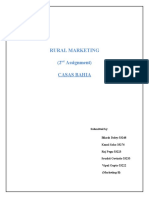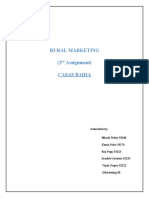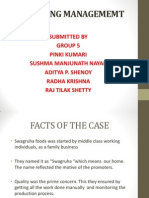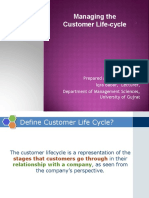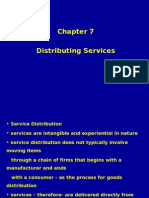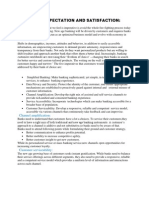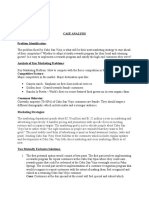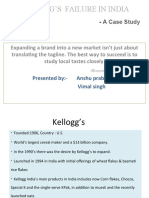0 ratings0% found this document useful (0 votes)
35 viewsCasas Bahia : Marketing To The Poor
Casas Bahia : Marketing To The Poor
Uploaded by
sudipsaintCasas Bahia is the largest retail chain in Brazil founded in 1958. It serves low-income consumers by providing flexible credit options allowing customers to purchase electronics, appliances, and furniture. Casas Bahia analyzes customers' creditworthiness and income within one minute to determine financing. It maintains emotional relationships with customers to achieve low default rates. While critics argue Casas Bahia exploits the poor, others note it increases purchasing power and economic growth by making products accessible through innovative financing.
Copyright:
Attribution Non-Commercial (BY-NC)
Available Formats
Download as PPTX, PDF, TXT or read online from Scribd
Casas Bahia : Marketing To The Poor
Casas Bahia : Marketing To The Poor
Uploaded by
sudipsaint0 ratings0% found this document useful (0 votes)
35 views11 pagesCasas Bahia is the largest retail chain in Brazil founded in 1958. It serves low-income consumers by providing flexible credit options allowing customers to purchase electronics, appliances, and furniture. Casas Bahia analyzes customers' creditworthiness and income within one minute to determine financing. It maintains emotional relationships with customers to achieve low default rates. While critics argue Casas Bahia exploits the poor, others note it increases purchasing power and economic growth by making products accessible through innovative financing.
Original Title
Casas Bahia - Copy
Copyright
© Attribution Non-Commercial (BY-NC)
Available Formats
PPTX, PDF, TXT or read online from Scribd
Share this document
Did you find this document useful?
Is this content inappropriate?
Casas Bahia is the largest retail chain in Brazil founded in 1958. It serves low-income consumers by providing flexible credit options allowing customers to purchase electronics, appliances, and furniture. Casas Bahia analyzes customers' creditworthiness and income within one minute to determine financing. It maintains emotional relationships with customers to achieve low default rates. While critics argue Casas Bahia exploits the poor, others note it increases purchasing power and economic growth by making products accessible through innovative financing.
Copyright:
Attribution Non-Commercial (BY-NC)
Available Formats
Download as PPTX, PDF, TXT or read online from Scribd
Download as pptx, pdf, or txt
0 ratings0% found this document useful (0 votes)
35 views11 pagesCasas Bahia : Marketing To The Poor
Casas Bahia : Marketing To The Poor
Uploaded by
sudipsaintCasas Bahia is the largest retail chain in Brazil founded in 1958. It serves low-income consumers by providing flexible credit options allowing customers to purchase electronics, appliances, and furniture. Casas Bahia analyzes customers' creditworthiness and income within one minute to determine financing. It maintains emotional relationships with customers to achieve low default rates. While critics argue Casas Bahia exploits the poor, others note it increases purchasing power and economic growth by making products accessible through innovative financing.
Copyright:
Attribution Non-Commercial (BY-NC)
Available Formats
Download as PPTX, PDF, TXT or read online from Scribd
Download as pptx, pdf, or txt
You are on page 1of 11
CASAS BAHIA
…MARKETING TO THE POOR
BACKGROUND OF THE COMPANY
• Founded by Samuel Klein in 1958,it is the largest
retail chain in Brazil which sells electronics,home
appliances and furnitures.
• Casas Bahia,named after home state Bahia,maintains
the philosophy of “total dedication to you”,i.e. the
customers.
• As of January 2005,it has 30000 employees,800 call
centres agents,394 stores in 8 states,11 million
customers(approx),more than 7000 items to offer to
its customers.
SERVING THE URBAN POOR
• They realized the hidden strength of the
consumers in low income group, put together.
• 70% of the Casas Bahia’s consumers has no
regular income.
• Developed a sustainable business model
focussing entirely on consumers constituting
lower-income group.
• Provided flexible and easy credit to them.
THE BUSINESS MODEL
• Credit financing formed the core of Casas
Bahia’s business model.
• Prospective customers are to submit
themselves to an SPC(Service of credit
Protection)system of credit check.
• If price of merchandise is more than $600 USD, then Casas
Bahia uses their computer evaluation system to determine
the credit limit based on total income, all done within 1
minute
• Credit analysts are trained to work with customers. If the
computer evaluation system rejects a customer, they can ask
the right questions to decide if the customer is sincere and
able to make the necessary payments.
• If customer is still rejected, analysts are trained to reject in a
manner that ensures a long-lasting relationship with
customers so that they will return when their circumstances
improve.
• They maintained the information of purchase history and
credit score and even personality traits of every customer
visiting their store for future reference.
• Used later to evaluate credit worthiness of its
clients,potential to purchase new items etc.
• Salespeople at Casas Bahia develop a rapport with
customers that guarantees an emotional endorsement to
the payment plans.
• By establishing an emotional relationship rather than
asking for proof of income, Casa Bahia achieves very low
default rates.
• Casas Bahia is the 4th most recognized brand in Brazil and it has used
its own brand as an endorser for new product categories. Casas Bahia
advertises heavily and spends 3% of total revenues on advertising.
• Main advertising venue is Television which reaches over 90% of all
Brazilian households and conveys the emotional “dreams come true”
proposition very effectively.
• Advertising is simple and features everyday people talking about how
they got their dream products at Casas Bahia
• Pricing is based on capacity to pay,so the strategy of them is
based upon- what can the customer afford and what payment
schedule can be designed to fit that customer? Thus, “making
their dreams come true.”
• There is a misconception that because the customers are poor,
they do not desire quality products—the only difference is that
customers at the BOP can’t afford to pay immediately for these
products.
• Consumers at the BOP are brand-conscious but not
necessarily product-conscious.
CRITICISM
• It exploited the poor by alluring them with
branded products in easy Installment.
• They took advantage of their vulnerabilities
and yearning for expensive consumer goods.
• They are forcing the poor to overlook their
own basic needs.
CONCLUSION
• Casas Bahia kept consumer spending active even when Brazil
economy was volatile.
• Innovative credit financing schemes strategy were seen as a
revolutionary step applicable in all developing countries in terms
of increment of purchasing power of masses,growth of economy.
• Consumers are aware they are paying high interest rates but do not
feel that they are being taken advantage of for various reasons :
• They don’t have any other options in terms of getting the financing.
• Without the financing options, they and their friends would not have the
opportunity to purchase TVs, fridges, and other appliances that they
now see in each others’ homes.
THANK YOU
You might also like
- Case 6-2 Wentworth Industrial Cleaning Supplies Strategic Marketing (Tenth Edition) - David & NigelDocument6 pagesCase 6-2 Wentworth Industrial Cleaning Supplies Strategic Marketing (Tenth Edition) - David & NigelSelina Jahan NithiNo ratings yet
- Customer Service Chapter 1Document26 pagesCustomer Service Chapter 1phamianick50% (2)
- Critcal Analysis Urban ThreadDocument15 pagesCritcal Analysis Urban ThreadZareen RehanNo ratings yet
- Online Marketing at Big Skinny - Group 3Document13 pagesOnline Marketing at Big Skinny - Group 3Zenish Khumujam100% (1)
- Cabo San Viejo CaseDocument2 pagesCabo San Viejo CaseAarjav ThakkarNo ratings yet
- Strategic Management of H&MDocument33 pagesStrategic Management of H&MGreeshma100% (7)
- CASAS BAHIA Summary of Case StudyDocument6 pagesCASAS BAHIA Summary of Case StudyRabi KhanNo ratings yet
- BBVA CompassDocument6 pagesBBVA Compassvisraghav60% (5)
- CBBE Model and Kapferers Identity PrismDocument12 pagesCBBE Model and Kapferers Identity Prismshashwat shuklaNo ratings yet
- CASAS BAHIA-Marketing To The PoorDocument8 pagesCASAS BAHIA-Marketing To The PoorAshley VargheseNo ratings yet
- Industry - Retail, Location - Brazil, Head Quarter-Sao PauloDocument17 pagesIndustry - Retail, Location - Brazil, Head Quarter-Sao PaulovidhyaaravinthanNo ratings yet
- Topic-Innovation in Retailing in Various CountriesDocument5 pagesTopic-Innovation in Retailing in Various CountriesNeeraj JainNo ratings yet
- Industry - Retail, Location - Brazil, Head Quarter-Sao PauloDocument13 pagesIndustry - Retail, Location - Brazil, Head Quarter-Sao PauloAlok MahajanNo ratings yet
- Casas BahiaDocument10 pagesCasas BahiaDiwan Rayan TahirNo ratings yet
- Rural Marketing (2 Assignment) Casas BahiaDocument8 pagesRural Marketing (2 Assignment) Casas BahiaRuy SantosNo ratings yet
- Rural Marketing (2 Assignment) Casas BahiaDocument8 pagesRural Marketing (2 Assignment) Casas BahiaKunal SahaNo ratings yet
- Asas Bahia Case StudyDocument33 pagesAsas Bahia Case StudyhmtejNo ratings yet
- Casas Bahia: Marketing To The PoorDocument9 pagesCasas Bahia: Marketing To The PoorAnamika TarafdarNo ratings yet
- Casas BahiaDocument13 pagesCasas BahiaGuruprasad NabarNo ratings yet
- Bbva Compass - Digital MarketingDocument10 pagesBbva Compass - Digital Marketingꀭꀤꌗꃅꀎ ꀘꍏꋪꂵꍏꀘꍏꋪNo ratings yet
- Sales Model in Financial Products: Dsa/Dma, Casa Strategy, Cross Selling, Priority BankingDocument12 pagesSales Model in Financial Products: Dsa/Dma, Casa Strategy, Cross Selling, Priority BankingRitikaNo ratings yet
- Group 5 Accounts Receivable Management CityShopsDocument34 pagesGroup 5 Accounts Receivable Management CityShopsJ. BartNo ratings yet
- SM PPT RBCDocument20 pagesSM PPT RBCAnkita KumariNo ratings yet
- CRM - Future Group Big BazaarDocument25 pagesCRM - Future Group Big BazaarAadit ShahNo ratings yet
- SwagruhaDocument11 pagesSwagruhaAditya MishraNo ratings yet
- Loyality Programs in Big Bazar (MR PPT) by VikasDocument19 pagesLoyality Programs in Big Bazar (MR PPT) by VikasVikas Dubey100% (4)
- Wal Mart and BIG BAZAAR: A Comparitive Analysis - Presentation TranscriptDocument2 pagesWal Mart and BIG BAZAAR: A Comparitive Analysis - Presentation TranscriptRohit SinghNo ratings yet
- Change in Kirana: Submitted by - Group 11 Pooja Shray Farhan Shashank SankalpDocument11 pagesChange in Kirana: Submitted by - Group 11 Pooja Shray Farhan Shashank SankalpPOOJA GUPTANo ratings yet
- Marketing Project - Cadbury KioskDocument29 pagesMarketing Project - Cadbury KioskSaini SikanderNo ratings yet
- Company Profile:: - "To Be The World's Premier Consumer Products Company FocusedDocument45 pagesCompany Profile:: - "To Be The World's Premier Consumer Products Company FocusedNilesh PatelNo ratings yet
- Big Bazaar CRMDocument18 pagesBig Bazaar CRMarjaav dhawanNo ratings yet
- Nectar: Making Loyalty PayDocument20 pagesNectar: Making Loyalty PayAmbuj Sinha0% (1)
- Premiere Hypermarket of India & Its Distribution Network A Case StudyDocument21 pagesPremiere Hypermarket of India & Its Distribution Network A Case StudyShourya AsthanaNo ratings yet
- Model: Submitted by Subham Chakraborty 0191PGM002 PGDM SapDocument10 pagesModel: Submitted by Subham Chakraborty 0191PGM002 PGDM SapSubham ChakrabortyNo ratings yet
- Amazon PPT CreativeDocument20 pagesAmazon PPT Creativeysbaware76No ratings yet
- Marketing PPDocument86 pagesMarketing PPavarinmanupheeraphanNo ratings yet
- Jugueria Business PlanDocument26 pagesJugueria Business PlanScribdTranslationsNo ratings yet
- Guest SlidesDocument474 pagesGuest Slidesnikaro1989No ratings yet
- BIG BASKET - Group 6Document9 pagesBIG BASKET - Group 6Febin CharlesNo ratings yet
- Bank Alfalah Marketing Plan: Presented To: Presented By: Reg#Document24 pagesBank Alfalah Marketing Plan: Presented To: Presented By: Reg#Jibran GhaniNo ratings yet
- My Kind of Cakes: Case Study AnalysisDocument7 pagesMy Kind of Cakes: Case Study AnalysisKRISHNA YELDINo ratings yet
- Principles of MarketingDocument4 pagesPrinciples of MarketingUme HabibaNo ratings yet
- Brand Imag1Document4 pagesBrand Imag1Beerappa RamakrishnaNo ratings yet
- A Project Report ON: "Retail Management of Big Bazaar"Document19 pagesA Project Report ON: "Retail Management of Big Bazaar"Avinash VermaNo ratings yet
- Managing The Customer Life-CycleDocument25 pagesManaging The Customer Life-CycleMaryam KhadimNo ratings yet
- Business Challenges BookletDocument24 pagesBusiness Challenges BookletProminent KV KambindaNo ratings yet
- Prestige Institute of Management and Research: Presentation On:Idbi Federal Life InsuranceDocument9 pagesPrestige Institute of Management and Research: Presentation On:Idbi Federal Life InsuranceadityaNo ratings yet
- Identify and Evaluate Marketing Opportunities: Assessment 1Document9 pagesIdentify and Evaluate Marketing Opportunities: Assessment 1Maykiza NiranpakornNo ratings yet
- Business CanvasDocument23 pagesBusiness Canvasregenazeineh73No ratings yet
- Casas Bahia Case StudyDocument2 pagesCasas Bahia Case StudyNel MateoNo ratings yet
- October 2024Document11 pagesOctober 2024dilraj.lftNo ratings yet
- SM 18 MarchDocument76 pagesSM 18 MarchMurtaza AdenwalaNo ratings yet
- Segmenting and Targeting: Dr. Abhilasha Jindal Asst. ProfessorDocument60 pagesSegmenting and Targeting: Dr. Abhilasha Jindal Asst. ProfessorShubham SinghNo ratings yet
- Click BankDocument15 pagesClick BankRizah Cortiguerra-GregorioNo ratings yet
- Individual Case Study BBVA DocxDocument5 pagesIndividual Case Study BBVA DocxSara Eva100% (1)
- Banking Products and Operations: Session 5Document41 pagesBanking Products and Operations: Session 5Vaidyanathan RavichandranNo ratings yet
- Presentation 1Document82 pagesPresentation 1Kinshuk SharmaNo ratings yet
- Banking Industry SegmentationDocument47 pagesBanking Industry SegmentationRajan RajNo ratings yet
- SWOT Analysis of A Coffee Shop BusinessDocument3 pagesSWOT Analysis of A Coffee Shop Businessruby singhNo ratings yet
- 70 Marketing Ideas: The Won't Break The BankDocument19 pages70 Marketing Ideas: The Won't Break The Banksimon7733100% (1)
- Customer Expectation and Satisfaction:: Channel AmplificationDocument12 pagesCustomer Expectation and Satisfaction:: Channel AmplificationAbhinandan JakharNo ratings yet
- Marketing 3 3Document15 pagesMarketing 3 3waqarahmedmir85No ratings yet
- Cabo San ViejoDocument3 pagesCabo San ViejoAarjav ThakkarNo ratings yet
- Subscription Success: A Guide to Building Profitable Subscription Box BusinessesFrom EverandSubscription Success: A Guide to Building Profitable Subscription Box BusinessesNo ratings yet
- Justin Beere Resume 2012Document2 pagesJustin Beere Resume 2012justin_beereNo ratings yet
- Macro Environment of NestleDocument10 pagesMacro Environment of NestleHanin AlfakhriNo ratings yet
- Kellogg's in IndiaDocument11 pagesKellogg's in IndiakamalNo ratings yet
- Business Model Canvas Sony Written ReportDocument10 pagesBusiness Model Canvas Sony Written ReportnatashiwacocoNo ratings yet
- A Study On Advertising and Promotional Strategies of Sri Krishna Ghee at Sadadnanda Foods Private Limited Nithin R, Dr. Sogra Khatoon, Dr. Mohammed Arif PashaDocument8 pagesA Study On Advertising and Promotional Strategies of Sri Krishna Ghee at Sadadnanda Foods Private Limited Nithin R, Dr. Sogra Khatoon, Dr. Mohammed Arif PashaRatan SikderNo ratings yet
- Demographic SegmentationDocument19 pagesDemographic Segmentationshashankvats26No ratings yet
- The Brainy Bunch - Marketing PlanDocument30 pagesThe Brainy Bunch - Marketing PlanGautam AryaNo ratings yet
- Case 1 Kelloggs - Using New Product Development To Grow A BrandDocument4 pagesCase 1 Kelloggs - Using New Product Development To Grow A BrandJackyHoNo ratings yet
- General Motors Swot AnalysisDocument3 pagesGeneral Motors Swot AnalysisAnkur Anil Nahata100% (1)
- Marketing Strategy of DellDocument78 pagesMarketing Strategy of DellAmit SinghNo ratings yet
- Business StrategyDocument36 pagesBusiness StrategyNgọc KhánhNo ratings yet
- The Importance of Personal Branding For Employers and StudentsDocument3 pagesThe Importance of Personal Branding For Employers and Studentsapi-306766547No ratings yet
- Mayur Presentation1Document40 pagesMayur Presentation1jagrutisolanki01No ratings yet
- Consumer PsychologyDocument26 pagesConsumer PsychologyMoon DeuraNo ratings yet
- Consumer Behavior Assignment: Stimulus GeneralizationDocument3 pagesConsumer Behavior Assignment: Stimulus GeneralizationSaurabh SumanNo ratings yet
- My Thesis in Marketing ResearchDocument17 pagesMy Thesis in Marketing Researchpeso manaboNo ratings yet
- Group 1 EntrepDocument8 pagesGroup 1 EntrepCresencio SamilingNo ratings yet
- Marketing Strategy of FujifilmDocument14 pagesMarketing Strategy of FujifilmPellNo ratings yet
- Brand ManagementDocument181 pagesBrand ManagementSáas JainNo ratings yet
- Research Title DefenseDocument19 pagesResearch Title DefenseJoyce AtienzaNo ratings yet
- GiliDocument19 pagesGiliKartik SharmaNo ratings yet
- Case Study 10 - Malaysian Airlines Versus AirAsia Customer Satisfaction, Service Quality and Service BrandingDocument9 pagesCase Study 10 - Malaysian Airlines Versus AirAsia Customer Satisfaction, Service Quality and Service BrandingNguyễn Thị Phong NhãNo ratings yet
- Fast Food Competition-3-29Document27 pagesFast Food Competition-3-29Thanh Hà TrầnNo ratings yet
- Gutierrez B (2003) - AndecDocument13 pagesGutierrez B (2003) - AndecPunch ButtfaceyNo ratings yet
- Resources, Conservation & Recycling: X: Patricia Megale Coelho, Blanca Corona, Roland Ten Klooster, Ernst Worrell TDocument11 pagesResources, Conservation & Recycling: X: Patricia Megale Coelho, Blanca Corona, Roland Ten Klooster, Ernst Worrell TAngelica PostreNo ratings yet














